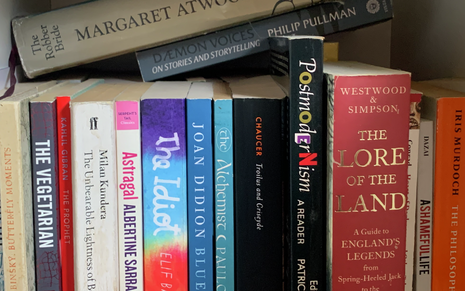Why do we love miserable books so much?
Inspired by a recent re-read of A Little Life, Senior Arts editor Emily Lawson-Todd questions why we love miserable books so much, arguing that misery does not automatically make something profound

A recent announcement that the 2015 critically acclaimed novel A Little Life had just started its run at the National Theatre led me to pick up my own copy, which for the past three years had been used as a variety of objects – tripod, step, doorstop (because, despite its title, little it ain’t) – basically anything other than a book for reading. The last time I’d attempted it, I’d barely got past the first page before tossing it aside. I thought a second read, this time after nearly two years studying English, would maybe allow me to persist a little more and see what the hype was all about.
“What we need to remember is how profound and moving happiness can be”
Well, I got further than one page. Forty-nine pages further, to be exact. Before I took the book and promptly threw it into the plastic bag titled “charity shop” where other victims of my spring cleaning resided.
I’m rarely a quitter when it comes to reading. In fact, I pride myself on being able to stomach just about anything. Grotesque descriptions of murder? Yes, please. Filth? Absolutely. War? Give me the whole kitchen sink, I say. But this book was simply so miserable, so infuriating in its refusal to let quite literally anything good happen, that I simply couldn’t bring myself to read any more of it. Reading the Wikipedia plot to see if I was missing out on the book getting any less self-indulgently wallowing, I was met with a plot that seemed as if it was ripped straight out of a 14-year-old’s fanfiction. Tragedies and misfortunes piled up on top of each other with such excess that it almost became perversely comic. I decided that I hadn’t missed anything at all, and went about my day nonplussed. But the question of why this melodramatic gorefest was frequently recommended as a “summer read” refused to leave my mind. Why does everyone love this book? I wondered. Are we all allergic to being happy or something?
Sure, there are easy questions to that answer that go along the “human nature bla bla, tragedies and what makes us human” line. However, I’m convinced that the popularity of a 700-page-plus book that seems to be playing the game “see how many horrible things can happen to one person” speaks to a more widespread belief when it comes to literature: that tragedy is the most sophisticated and clever form of writing. Of course, to argue that tragedy isn’t profound would be flat-out wrong; the fact that the English Faculty has an entire mandatory paper dedicated to the stuff stands as proof enough that sad lit is an undeniably important part of the canon. Unfortunately, far too many writers believe that by throwing their characters throw the (sometimes literal) depths of hell, their work is automatically a Great Work of Literature, which feels like a very lazy shorthand that irritatingly works quite well.
“In a world that’s undeniably rather miserable sometimes, isn’t it profound to try and seek the happiness around us?”
In her work, The Ones That Walk Away From Omelas, Ursula Le Guin states: “the trouble is that we have a bad habit [...] of considering happiness as something rather stupid. Only pain is intellectual, only evil interesting.” From looking at our tendency to label any book that has sad stuff happen in it as a poignant piece of literature regardless of actual writing quality, I’d say she’s right. Yet what we need to remember is how profound and moving happiness can be. Angela Carter’s Wise Children is an undoubtedly silly book that for some bizarre reason makes me cry with its line “What a joy it is to dance and sing!” The reason Wendy Cope’s poem “The Orange” with its statement “I love you / I’m glad I exist” frequently worms its way onto people’s top poems lists is not because it’s mired in some horrendous tragedy, but rather because of how joyous it is, and how touching it is in its celebration of the everyday. Even Jacqueline Wilson – the undisputed queen of traumatically tragic children’s books – intersperses her tales of woe with humour, in a way drawing on a longer-standing literary tradition that can be found in many works written in times of tragedy, the ability to laugh in the face of despair.
Of course, I may be in the minority here. A Little Life continues to be ragingly popular, so I’m sure that the author’s pockets are not going to hurt based on the opinion of one student journalist who is sick of reading sad books in their droves and pretending that just because something is miserable it’s also automatically profound. Maybe I’m too shallow to appreciate tragic works, but in a world that’s undeniably rather miserable sometimes, isn’t it profound to try and seek the happiness around us?
 Comment / Cambridge is right to scrap its state school target1 May 2024
Comment / Cambridge is right to scrap its state school target1 May 2024 News / Academics call for Cambridge to drop investigation into ‘race realist’ fellow2 May 2024
News / Academics call for Cambridge to drop investigation into ‘race realist’ fellow2 May 2024 News / Gender attainment gap to be excluded from Cambridge access report3 May 2024
News / Gender attainment gap to be excluded from Cambridge access report3 May 2024 News / Cambridge postgrad re-elected as City councillor4 May 2024
News / Cambridge postgrad re-elected as City councillor4 May 2024 Comment / Accepting black people into Cambridge is not an act of discrimination3 May 2024
Comment / Accepting black people into Cambridge is not an act of discrimination3 May 2024





